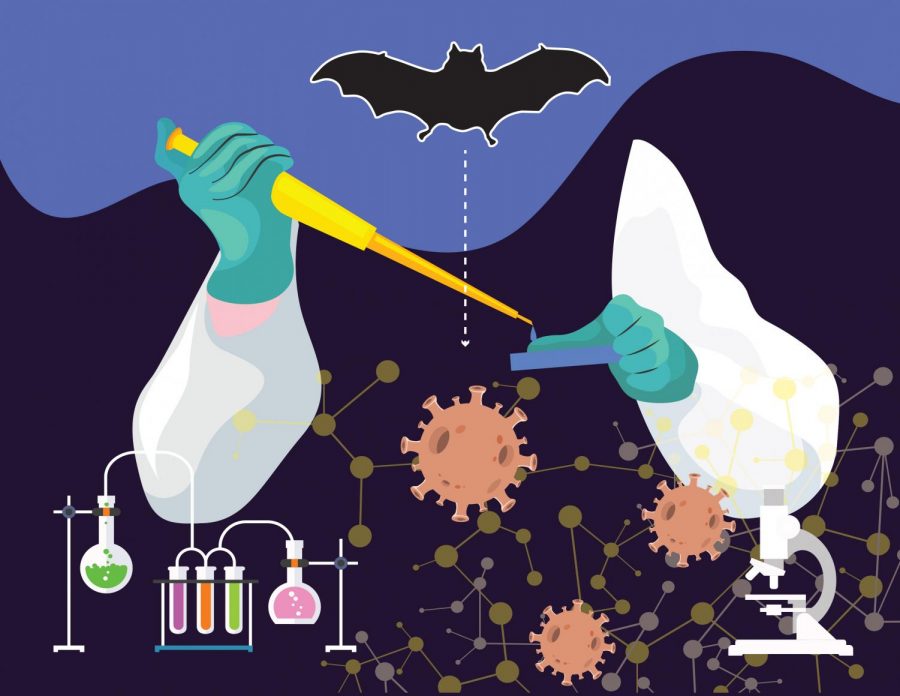Bats must be studied more to understand transmission of viruses, researchers say
COVID-19 disease likely came from bats; other coronaviruses could threaten human health, according to a literature review
Scientists do not fully understand how bats have so many viruses that can spill over to humans, a WSU researcher says. When humans contract a virus from bats, it can cause disease and death.
July 20, 2020
In a literature review, WSU researchers determined bats must be studied more. This is because scientists do not know enough about how to lessen the threats they pose to human health.
When bat viruses jump to another species, they tend to be highly pathogenic, said Stephanie Seifert, assistant professor in the Paul G. Allen School for Global Animal Health. This means the viruses have a high mortality rate, are invasive and cause disease. Bats have caused Ebola, Severe Acute Respiratory Syndrome and Nipah virus in humans.
“We need to study these animals more and the viruses and the pathogens that they harbor in order to understand and better anticipate the next emerging virus,” said Michael Letko, assistant professor in the Paul G. Allen School for Global Animal Health.
Scientists do not fully understand how bats have so many viruses that can spill over to humans, Letko said. When humans contract a virus from bats, it can cause disease and death.
Part of this is because bats’ immune systems are drastically different than humans’ immune systems, so how bats and humans respond to a certain virus is different, he said.
However, scientists realize that more viruses are spilling over from bats to humans because humans are taking over bats’ territories. As deforestation continues, people have more contact with bats. This leads to increased exposure to the pathogens they carry, Letko said.
People likely have a lot of potential exposure to bat viruses where nothing really happens, Seifert said.
“It’s just every so often that you have a virus that can affect humans and then lead to onward transmission, which is what we’re seeing with [COVID-19],” Seifert said.
In many cases, scientists do not yet understand whether or not a bat virus can affect humans, and if so, whether it will be passed onto other people, she said.
Bats are the host species of many other coronaviruses, although there is no direct evidence that bats are the host species of SARS-CoV-2, the virus that causes COVID-19, Letko said. Researchers have found close relatives of SARS-CoV-2 in bats, but the actual virus has not been found.
It is very likely that SARS-CoV-2 came from bats, he said.
The literature review started well before the pandemic, Letko said.
“As this new virus was coming out, it was just underscoring all the points that we were trying to make in the article,” he said.
Viruses from bats are a risk to human health. Many SARS-like coronaviruses have the potential to pose a threat to humans for at least a decade, Seifert said.
In Australia, Hendra virus, which came from bats, spilled over to horses and then to humans. The bats feed in the same pastures as the horses do, and the bats can have Hendra virus in their urine. The horses can then contract the virus, Seifert said.
Once it is understood how a species contracts the virus from bats, a solution can be found. In this case, the pasture can be moved, so the horses are farther away from the bats, she said.
Another part of the solution is to bring back some of the bats’ natural habitat, she said. Deforestation led to bats and horses to live closer together, causing the issue.
“If we can understand instead how we get that spillover, then that I think is a big step in us being able to mitigate that potential spillover event into the human population without necessarily having a vaccine,” Seifert said.
There are obstacles in creating vaccines, she said. They are difficult to develop, especially with viruses like coronaviruses. There are so many coronaviruses, which makes it challenging to come up with a vaccine that can protect against all of them. Additionally, some diseases are not common enough for scientists to spend time making a vaccine.
Scientists knew before this pandemic that humans have frequent exposure to SARS-like coronaviruses. Other lineages of coronaviruses can also jump from other species to humans.
There are novel coronaviruses in other domestic and wild animals. However, scientists do not know whether these viruses can jump to humans, and if so, how many of them can, Seifert wrote in an email.
Scientists need to know which coronaviruses are threats to human health, what interactions could cause a virus to jump from one species to another and how to limit that exposure, she wrote in an email.











Tod Merley • Jul 21, 2020 at 11:19 am
I think we need to look at the big picture.
We are a holobiont. Our “me” cells are kind of like the earth. The many trillions of virus, retrovirus, bacteria, archaea, the various forms of fungi, protists, mites, and helminths that populate the internals and externals form the planet “me” populace. These also extend as a cloud for three or so feet around “me” as well. We are not alone even within ourselves.
A lecture given for the NIH by Herbert W. ‘Skip’ Virgin IV, M.D., Ph.D. at the Washington University School of Medicine on April 22, 2015 simply fascinates me. From the viewpoint of our virome he outlines recent research demonstrating how interactive our “populace” really is. States of disease or symbiosis depend upon the neighbors of the potential pathogen to a very great extent. A potential pathogen with different neighbors turns into a cuddly symbiont.
So perhaps the “neighbors” offered in Taiwan and Vietnam largely change how the SARS-CoV-2 virus expresses itself? Well I suppose that diet, lifestyle, and pollution are also factors.